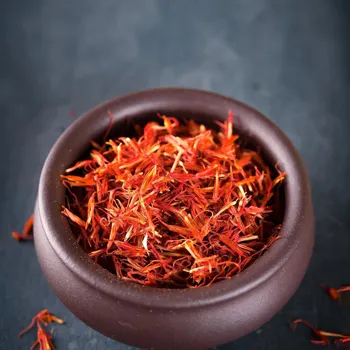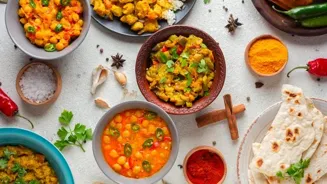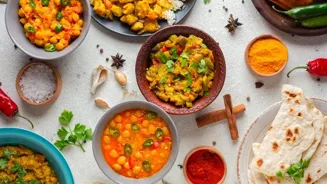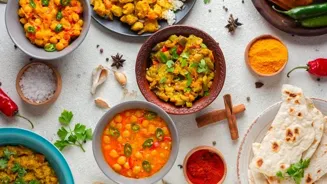Unveiling the Enchanting World of Indian Spices! Dive into the realm of flavorful blends that will revolutionize your cooking!
Namaste, food lovers! Are you ready to embark on a flavourful journey right
from your very own kitchen? Indian cuisine, known globally for its vibrant tastes and aromatic spices, might seem intimidating. But fear not! Unlocking the secrets of Indian cooking is easier than you think.
The key lies in mastering a few essential spice blends, also known as masalas. These carefully curated combinations can elevate even the simplest of vegetarian dishes, adding layers of depth and complexity that will tantalize your taste buds.
Forget bland and boring, get ready to discover the magic of Indian spices and transform your cooking into a delightful culinary adventure! This guide will introduce you to six indispensable spice blends that every aspiring Indian cook should have in their pantry.
Garam Masala: The Warm Embrace
Garam masala, literally meaning "warm spice mixture," is a cornerstone of Indian cooking. It’s typically added towards the end of the cooking process to impart a warm, fragrant finish. The blend often includes cinnamon, cardamom, cloves, cumin, coriander, black peppercorns, and nutmeg.
Some regional variations might include bay leaves, mace, or star anise. Garam masala isn't about making a dish spicy; instead, it provides warmth and complexity. It adds a beautiful aromatic fragrance that elevates even the basic dish.
The best practice is to gently roast the spices before grinding them to unlock their full potential. A good quality garam masala should smell intensely fragrant and the taste should provide a mix of sweet and savory flavors.
This versatile blend can be used in everything from vegetable curries and lentil soups (dal) to rice dishes and even sprinkled over snacks like roasted vegetables. The perfect garam masala is a delicate balance of sweet and savory elements.
Experiment with different ratios of spices to find a blend that suits your taste. A pinch of garam masala goes a long way to transform a regular dish into something special. You can also buy pre-made garam masala available in any grocery stores in India.
Chaat Masala: The Tangy Twist
Chaat masala is the secret ingredient behind India's incredibly popular street food snacks, or chaats. This tangy, slightly spicy blend is what gives these snacks their addictive quality. The key ingredient in chaat masala is amchur (dried mango powder), which lends a unique sourness.
Other common ingredients include cumin, coriander, black salt (kala namak), ginger powder, black pepper, asafoetida (hing), and chili powder. Black salt gives chaat masala a distinctive sulfurous aroma, which adds to its complex flavour profile.
Chaat masala is primarily used as a sprinkling over finished dishes. Think of it as the Indian equivalent of a finishing salt. It's fantastic on fruit salads, vegetable salads, potato dishes (like aloo tikki), and even sprinkled on a simple sandwich.
The tangy, spicy, and slightly pungent flavors of chaat masala awaken the taste buds. For example, for a healthy and refreshing snack, try sprinkling a pinch of chaat masala over sliced cucumbers and tomatoes! Its popularity comes from its ability to drastically improve a dish with just a sprinkle.
Tandoori Masala: The Smoky Sensation
Tandoori masala is most famously known for its use in tandoori dishes, which are traditionally cooked in a tandoor oven (a clay oven).

It typically includes ginger, garlic, garam masala spices (cumin, coriander, cardamom, cloves, cinnamon, black pepper), chili powder, and sometimes fenugreek leaves (kasoori methi).
The spice blend derives its signature red colour from Kashmiri chili powder or a touch of red food coloring (though natural options like beetroot powder can be used). The key is to marinate the vegetables in a mixture of tandoori masala and yogurt.
This allows the flavours to penetrate deeply and tenderize the veggies.
While traditionally used for dishes cooked in a tandoor, you can easily recreate the smoky flavour at home using your oven, grill, or even a stovetop pan.
This versatile masala is not only ideal for tandoori paneer or tandoori mushrooms, but can also be used to add a delicious layer of flavour to grilled vegetables or baked potatoes. A vibrant spice blend that's sure to impress!
Experiment with different vegetables to create your own tandoori masterpieces! Making your own tandoori vegetables in the oven will feel authentic with tandoori masala.
Sambar Masala: The South Indian Staple
Sambar is a lentil-based vegetable stew that is a staple in South Indian cuisine. Sambar masala is the aromatic spice blend that gives this iconic dish its unique flavour.
The blend usually consists of coriander seeds, cumin seeds, fenugreek seeds, dried red chilies, asafoetida (hing), curry leaves, and sometimes mustard seeds and black peppercorns. Some regional variations also include dried coconut.
Roasting the spices before grinding them is essential to bring out their full aroma and flavour. The aroma of the sambar masala itself is enough to make your stomach rumble!
Sambar masala is the heart and soul of good sambar.
It’s what gives it that characteristic tangy, savoury, and slightly spicy flavour. Add it to your cooked lentils and vegetables along with tamarind pulp for that authentic South Indian taste. You can adjust the amount of sambar masala to control the spiciness of the dish.
Experiment by adding different types of vegetables to your sambar to create your own signature variations! A delicious, healthy, and comforting dish that’s perfect for any meal. To elevate the taste, add some curry leaves to your sambar.
Pav Bhaji Masala: The Mumbai Street Food Star
Pav bhaji is a popular Mumbai street food dish consisting of a spiced vegetable mash (bhaji) served with buttered bread rolls (pav). Pav bhaji masala is a special spice blend that gives this iconic dish its unique and irresistible flavour.
The blend typically includes coriander seeds, cumin seeds, dried red chilies, turmeric powder, amchur (dried mango powder), asafoetida (hing), black pepper, cloves, cinnamon, cardamom, and dried ginger powder.
The balance of spices is crucial for achieving that signature pav bhaji flavour – a perfect blend of spicy, tangy, and savoury.
Pav bhaji masala is added to the vegetable mash while it’s cooking, infusing it with its complex flavour.
You can also sprinkle a little extra on top just before serving for an extra burst of flavour. While primarily used for pav bhaji, this masala can also be used to add flavour to other vegetable dishes or even sprinkled on potatoes.
To make authentic pav bhaji, use fresh vegetables such as potatoes, cauliflower, peas, and carrots. Use this spice to make excellent pav bhaji at the home to bring the streets of Mumbai to your house.
Biryani Masala: The Aromatic Rice Delight
Biryani is a layered rice dish that is loved across India. Biryani masala is the complex and aromatic spice blend that gives this dish its distinctive flavour.
The blend typically includes a mix of warm spices like cumin, coriander, cardamom, cloves, cinnamon, nutmeg, mace, bay leaves, and star anise. It often also includes ginger, garlic, chili powder, and sometimes saffron.
The key to a good biryani masala is the quality of the spices and the balance of flavours.
Biryani masala is used to flavour the rice and the vegetables (or other ingredients) that are layered together to make biryani.
Each layer of rice and vegetables gets infused with the aromatic spices, creating a symphony of flavors. The best result comes when you allow the biryani to "dum" for a while, meaning cooking it on low heat in a sealed pot to allow the flavours to meld together.
A truly decadent and flavourful dish that's perfect for special occasions. Cooking biryani requires patience, but the results are worth it. Aromatic spices like saffron elevates the dish to another level and brings in a royal flavor to your home.









